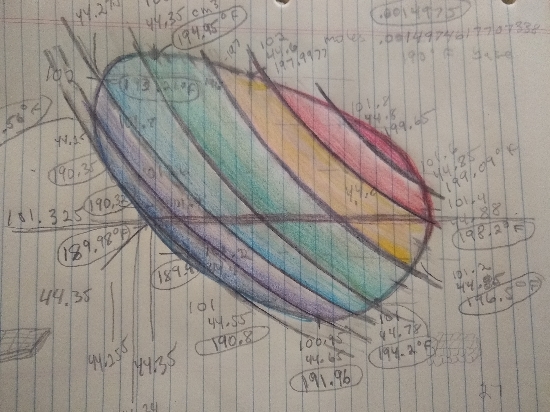During a conventional discussion of heat engines it is customary to break a PV diagram into four idealized processes. That's for the ease of seeing and explaining what happens for each and the whole cycle. Real engines mimic those ideal processes, but for the most part are not all that close. So, let us just use a real PV diagram. You have provided the following.

- Resize_20230522_031849_9086.jpg (175.66 KiB) Viewed 6577 times
If one starts drawing vertical, constant volume lines, the left most line, barely touching the curve, is top dead center TDC, also known as minimum volume, or V-min. The right most line is BDC, V-max.
Thanks for adding constant temperature, isothermal, lines. If a process follows an isotherm, temperature doesn't change. Please notice there are two short parts of the path that mimic isotherms. Lower left and upper right, corresponding to the end of the compression stroke and the other to the end of the expansion stroke. Any temperature change is depicted by a move off or across those lines.
One also can notice that there aren't any distinct separate processes. It is just a smooth curving loop cycling back onto itself. That is caused by the mechanisms mimicking harmonic motion.
There is no single process where we can observe heat being converted to work.
Work is displayed on this chart by a change in volume. The vertical line displaying zero work. Moving to the right positive work output. Moving to the left negative work output, or positive work input, to the working gas.
If there were adiabatic lines drawn on the chart, we could see lines of zero heat. Heat is thermal energy change, ∆Q. We will need to visualize them. Adiabatic lines are steeper than isotherms.

- Entropyandtemp.PNG (79.69 KiB) Viewed 6577 times
If heat is added without work, a constant volume line will be followed. That line will cross both adiabats and isotherms. This means that heat is added and temperature changes without any work.
The loop, for the complete cycle, crosses many isotherms, adiabats, and constant volume lines. That makes it a summation of all the work (constant volume) it crosses, positive and negative, depending on the left or right direction as it crosses. And it is a summation of all the heat (adiabats) it crosses. That area of work and area of heat are equal. They do not cancel. They are equal. One is added going in, the other comes out. It takes the entire loop to measure this. There is no subprocess where heat is converted to work. Therefore heat appears to be converted to work somewhere in the whole cycle, not any single conversion process.
Also, heat increases internal energy. Higher internal energy is reflected by an increase of pressure and or volume. Pressure pushes the piston as volume increases, producing work. It's hard to say exactly where and heat is converted, so it looks as if it's converted. And I never used the word "just".